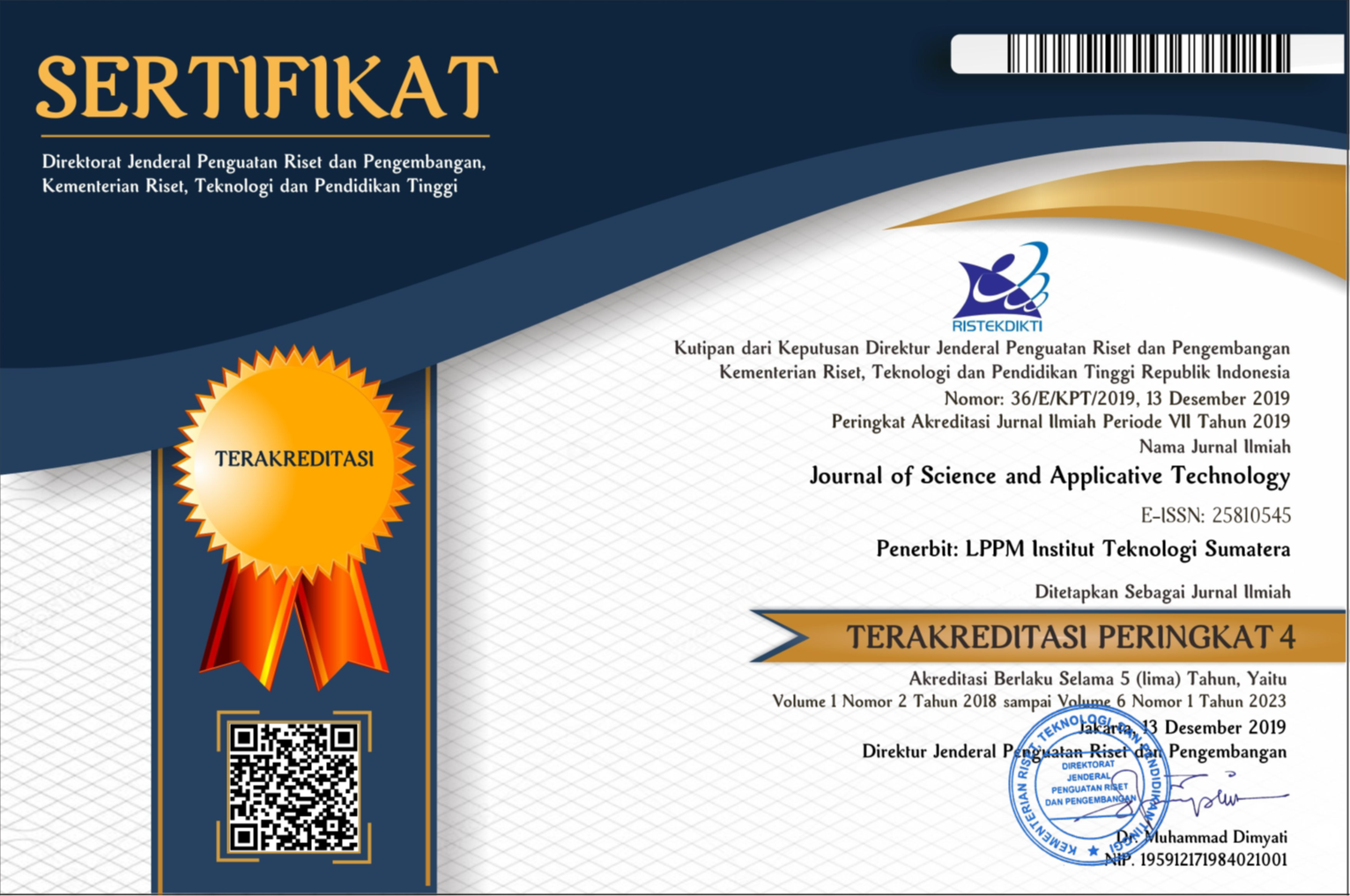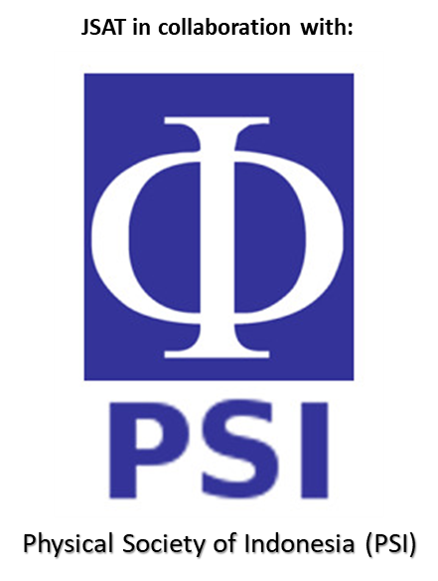Distribusi spasial kualitas perairan dan hubungannya dengan aktifitas budidaya perikanan di Teluk Lampung
Abstract
Coastal water is water areas that receive much input of organic matter originating from human activities on land. Anthropogenic activities such as marine aquaculture in Teluk Lampung impact water quality on that waters. This study was conducted to determine the distribution of water quality around Teluk Lampung and its correlations to marine aquaculture activities. The analysis carried out in this study is spatial analysis to determine the spatial distribution of water quality in three focus area, namely Teluk Hurun (HB), Selatan Teluk Hurun (SHB) dan Pantai Sari Ringgung (SRB) as part of Teluk Lampung. In addition to spatial analysis, principal component analysis (PCA) was also carried out to determine water quality as a variable and its correlation to each area. Based on the results of this study, the spatial distribution of water quality varies based on the human activities type in each area. Based on the results of principal component analysis, it is known that the variability of several water quality variables also correlates with the human activities types, such as marine aquaculture and beach tourism.
Downloads
References
[2] G. Cervetto, C. Mesones, and D. Calliari, “Phytoplankton biomass and its relationship to environmental variables in a disturbed coastal area of the Rio de la Plata, Uruguay, before the new sewage collector system.,” Atlântica, vol. 24, no. 1, pp. 45–54, 2002.
[3] R. R. Gentry et al., “Mapping the global potential for marine aquaculture,” Nat. Ecol. Evol., vol. 1, no. 9, pp. 1317–1324, 2017.
[4] N. Irawati, “PENDUGAAN KESUBURAN PERAIRAN BERDASARKAN SEBARAN NUTRIEN DAN KLOROFIL-A DI TELUK KENDARI SULAWESI TENGGARA,” AQUASAINS J. ILMU Perikan. DAN Sumberd. Perair., vol. 3, no. 1, pp. 193–199, 2014.
[5] B. Campbell and D. Pauly, “Mariculture: a global analysis of production trends since 1950,” Mar. Policy, vol. 39, pp. 94–100, 2013.
[6] R. J. Goldburg, M. S. Elliott, R. L. Naylor, P. O. Commission, and others, “Marine aquaculture in the United States: environmental impacts and policy options,” 2001.
[7] M. Holmer, “Environmental issues of fish farming in offshore waters: perspectives, concerns and research needs,” Aquac. Environ. Interact., vol. 1, no. 1, pp. 57–70, 2010.
[8] A. Sudrajat, H. Supriyadi, and A. Saputra, “Evaluasi perairan Waduk Cirata sebagi kawasan budidaya ikan dalam mendukung peningkatan ketahanan pangan [Laporan kegiatan],” Badan Peneliti dan Pengemb. Kelaut. dan Perikanan., Pus. Peneliti dan Pengemb. Perikan. Budid., vol. 22, 2010.
[9] Verawati, “Analisis Kualitas Air Laut Di Teluk Lampung,” pp. 2–91, 2016.
[10] A. Irawan, Q. Hasani, and H. Yuliyanto, “Fenomena Harmful Algal Blooms (HABs) di Pantai Ringgung Teluk Lampung, Pengaruhnya dengan Tingkat Kematian Ikan yang Dibudidayakan pada Karamba Jaring Apung,” J. Penelit. Pertan. Terap., vol. 15, no. 1, pp. 48–53, 2017.
[11] J. T. O. Kirk, “Use of a Quanta Meter to Measure Attenuation and Underwater Reflectance of Photosynthetically Active Radiation in Some Inland and Coastal South-Eastern Australian Waters,” Mar. Freshw. Res., vol. 28, no. 1, pp. 9–21, 1977.
[12] T. Parsons, M. Takahashi, and B. Hargrave, Biological oceanographic processes. Elsevier, 2013.
[13] F. W. Gilcreas, “Standard methods for the examination of water and waste water.,” Am. J. Public Heal. Nations Heal., vol. 56, no. 3, pp. 387–388, 1966.
[14] APHA, “Standard methods for the examination of water and wastewater 21st Edition Method 5310 B. High temperature combustion method,” in Standard Methods for the Examination of Water and Wastewater, APHA, AWWA, WEF Washington DC, USA, 2005, pp. 5–21.
[15] G. H. Pramono, “Akurasi Metode IDW dan Kriging untuk Interpolasi Sebaran Sedimen Tersuspensi di Maros, Sulawesi Selatan,” Forum Geogr., vol. 22, no. 2, p. 145, 2008.
[16] A. Rustam and F. Y. Prabawa, “Kualitas perairan di pantai punai dan pantai tambak kabupaten belitung timur,” J. Segara, vol. 11, no. 1, pp. 75–84, 2015.
[17] M. Nuzapril, S. B. Susilo, and J. P. Panjaitan, “Sebaran Produktivitas Primer Kaitannya Dengan Kondisi Kualitas Air Di Perairan Karimun Jawa,” J. Segara, vol. 15, no. 1, pp. 9–17, 2019.
[18] A. Tovar, C. Moreno, M. P. Mánuel-Vez, and M. García-Vargas, “Environmental impacts of intensive aquaculture in marine waters,” Water Res., vol. 34, no. 1, pp. 334–342, 2000.
[19] C. W. Tan, A. Thishalini, E. G. Goh, and S. Edlic, “Studies on turbidity in relation to suspended solid, velocity, temperature, pH, conductivity, colour and time,” ARPN J. Eng. Appl. Sci., vol. 12, no. 19, pp. 5626–5635, 2017.
[20] N. A. Wahab et al., “Assessments of lake profiling on temperature, Total Suspended Solid (TSS) and turbidity in the Kenyir Lake, Terengganu, Malaysia,” J. Fundam. Appl. Sci., vol. 9, no. 2S, pp. 256–278, 2017.
[21] E. Estévez, T. Rodríguez-Castillo, A. M. González-Ferreras, M. Cañedo-Argüelles, and J. Barquín, “Drivers of spatio-temporal patterns of salinity in Spanish rivers: a nationwide assessment,” Philos. Trans. R. Soc. B, vol. 374, no. 1764, p. 20180022, 2019.
[22] C. Deser, M. A. Alexander, S. P. Xie, and A. S. Phillips, Sea surface temperature variability: Patterns and mechanisms, vol. 2, no. 1. 2010.
[23] T. D. Kuswanto, M. L. Syamsuddin, and Sunarto, “Hubungan Suhu Permukaan Laut dan Klorofil-a Terhadap Hasil Tangkapan Ikan Tongkol di Teluk Lampung,” J. Perikan. dan Kelaut., vol. VIII, no. 2, pp. 90–102, 2017.
[24] P. Pitta, M. Tsapakis, E. T. Apostolaki, T. Tsagaraki, M. Holmer, and I. Karakassis, “‘Ghost nutrients’ from fish farms are transferred up the food web by phytoplankton grazers,” Mar. Ecol. Prog. Ser., vol. 374, pp. 1–6, 2009.
[25] V. Siregar and A. F. Koropitan, “Primary Productivity of Jakarta Bay in A Changing Environment: Climate Change and Anthropogenic Impacts,” BIOTROPIA-The Southeast Asian J. Trop. Biol., vol. 20, no. 2, 2013.
[26] A. D. Santoso, “Kualitas Nutrien Perairan Teluk Hurun, Lampung,” EnviroScienteae, vol. 7, no. 2, pp. 140–144, 2011.
[27] B. T. Hargrave, Environmental effects of marine finfish aquaculture. Springer, 2005.
[28] S. M. Vallina, P. Cermeno, S. Dutkiewicz, M. Loreau, and J. M. Montoya, “Phytoplankton functional diversity increases ecosystem productivity and stability,” Ecol. Modell., vol. 361, pp. 184–196, 2017.
[29] C. Zhang and M. I. N. Han, “Mapping chlorophyll-a concentration in Laizhou Bay using Landsat 8 OLI data,” in Proceedings of the 36th IAHR World Congress. Netherland, 2015.
[30] J. T. O. Kirk, Light and photosynthesis in aquatic ecosystems, third edition. 2011.
[31] A. Bricaud, A. Morel, and L. Prieur, “Absorption by dissolved organic matter of the sea (yellow substance) in the UV and visible domains1,” Limnol. Oceanogr., vol. 26, no. 1, pp. 43–53, 1981.
[32] R. Schulz, S. K. C. Peall, J. M. Dabrowski, and A. J. Reinecke, “Current-use insecticides, phosphates and suspended solids in the Lourens River, Western Cape, during the first rainfall event of the wet season,” Water SA, vol. 27, no. 1, pp. 65–70, 2001.
Copyright (c) 2022 Journal of Science and Applicative Technology

This work is licensed under a Creative Commons Attribution-NonCommercial 4.0 International License.
All the content on Journal of Science and Applicative Technology (JSAT) may be used under the terms of the Creative Commons Attribution-NonCommercial 4.0 International License.
You are free to:
- Share - copy and redistribute the material in any medium or format
- Adapt - remix, transform, and build upon the material
Under the following terms:
- Attribution - You must give appropriate credit, provide a link to the license, and indicate if changes were made. You may do so in any reasonable manner, but not in any way that suggests the licensor endorses you or your use.
- NonCommercial - You may not use the material for commercial purposes.
- No additional restrictions - You may not apply legal terms or technological measures that legally restrict others from doing anything the license permits.





















